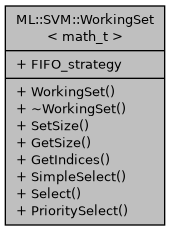#include <workingset.h>

Public Member Functions | |
| WorkingSet (const raft::handle_t &handle, cudaStream_t stream, int n_rows=0, int n_ws=0, SvmType svmType=C_SVC) | |
| Manage a working set. More... | |
| ~WorkingSet () | |
| void | SetSize (int n_train, int n_ws=0) |
| Set the size of the working set and allocate buffers accordingly. More... | |
| int | GetSize () |
| int * | GetIndices () |
| Return a device pointer to the the working set indices. More... | |
| void | SimpleSelect (math_t *f, math_t *alpha, math_t *y, const math_t *C, int n_already_selected=0) |
| Select new elements for a working set. More... | |
| void | Select (math_t *f, math_t *alpha, math_t *y, const math_t *C) |
| Select working set indices. More... | |
| int | PrioritySelect (math_t *alpha, const math_t *C, int nc) |
| Select elements from the previous working set based on their priority. More... | |
Public Attributes | |
| bool | FIFO_strategy = true |
More... | |
Detailed Description
template<typename math_t>
class ML::SVM::WorkingSet< math_t >
Working set selection for the SMO algorithm.
The working set is a subset of the training vectors, by default it has 1024 elements. At every outer iteration in SmoSolver::Solve, we select a different working set, and optimize the dual coefficients for the working set.
The vectors are selected based on the f values, which is the difference between the target label and the decision function value.
Constructor & Destructor Documentation
◆ WorkingSet()
|
inline |
Manage a working set.
- Parameters
-
handle cuml handle implementation stream cuda stream for working set operations n_rows number of training vectors n_ws number of elements in the working set (default 1024) svmType classification or regression
◆ ~WorkingSet()
|
inline |
Member Function Documentation
◆ GetIndices()
|
inline |
Return a device pointer to the the working set indices.
The returned array is owned by WorkingSet.
◆ GetSize()
|
inline |
Return the size of the working set.
◆ PrioritySelect()
| int ML::SVM::WorkingSet< math_t >::PrioritySelect | ( | math_t * | alpha, |
| const math_t * | C, | ||
| int | nc | ||
| ) |
Select elements from the previous working set based on their priority.
We sort the old working set based on their priority in ascending order, and then select nc elements from free, and then lower/upper bound vectors. For details see [2].
See Issue #946.
References: [2] T Serafini, L Zanni: On the Working Set selection in grad. projection based decomposition techniques for Support Vector Machines DOI: 10.1080/10556780500140714
- Parameters
-
[in] alpha device vector of dual coefficients, size [n_train] [in] C penalty parameter [in] nc number of elements to select
◆ Select()
|
inline |
Select working set indices.
To avoid training vectors oscillating in and out of the working set, we keep half of the previous working set, and fill new elements only to the other half.
We can have a FIFO retention policy, or we can consider the time (=ws_priority) a vector already spent in the ws. References: [1] Z. Wen et al. ThunderSVM: A Fast SVM Library on GPUs and CPUs, Journal of Machine Learning Research, 19, 1-5 (2018)
- Parameters
-
f optimality indicator vector, size [n_train] alpha dual coefficients, size [n_train] y class labels, size [n_train] C penalty parameter vector, size [n_train]
◆ SetSize()
|
inline |
Set the size of the working set and allocate buffers accordingly.
- Parameters
-
n_train number of training vectors n_ws working set size (default min(1024, n_train))
◆ SimpleSelect()
| void ML::SVM::WorkingSet< math_t >::SimpleSelect | ( | math_t * | f, |
| math_t * | alpha, | ||
| math_t * | y, | ||
| const math_t * | C, | ||
| int | n_already_selected = 0 |
||
| ) |
Select new elements for a working set.
Here we follow the working set selection strategy by Joachims [1], we select n training instances as:
- select n/2 element of upper set, where f is largest
- select n/2 from lower set, where f is smallest
The difference compared to Joachims' strategy is that we can already have some elements selected by a different strategy, therefore we select only n = n_ws - n_already_selected.
References: [1] Joachims, T. (1998). Making large-scale support vector machine learning practical. In B. Scholkopf, C. Burges, & A. Smola (Eds.), Advances in kernel methods: Support vector machines. Cambridge, MA: MIT Press
- Parameters
-
f optimality indicator vector, size [n_train] alpha dual coefficients, size [n_train] y target labels (+/- 1) C penalty parameter vector size [n_train] n_already_selected
Member Data Documentation
◆ FIFO_strategy
| bool ML::SVM::WorkingSet< math_t >::FIFO_strategy = true |
Workspace selection strategy, note that only FIFO is tested so far
The documentation for this class was generated from the following file:
- src/svm/workingset.h